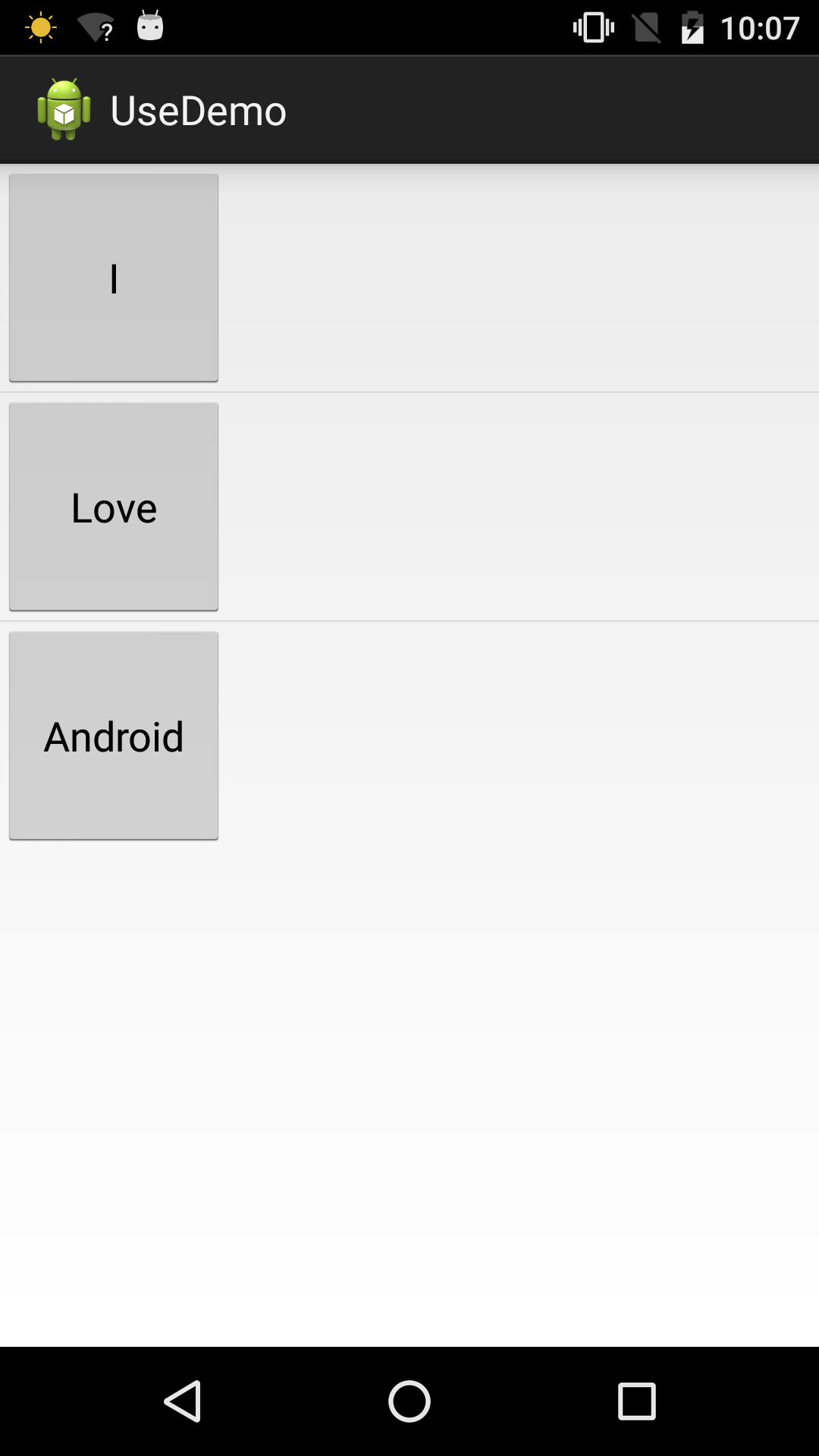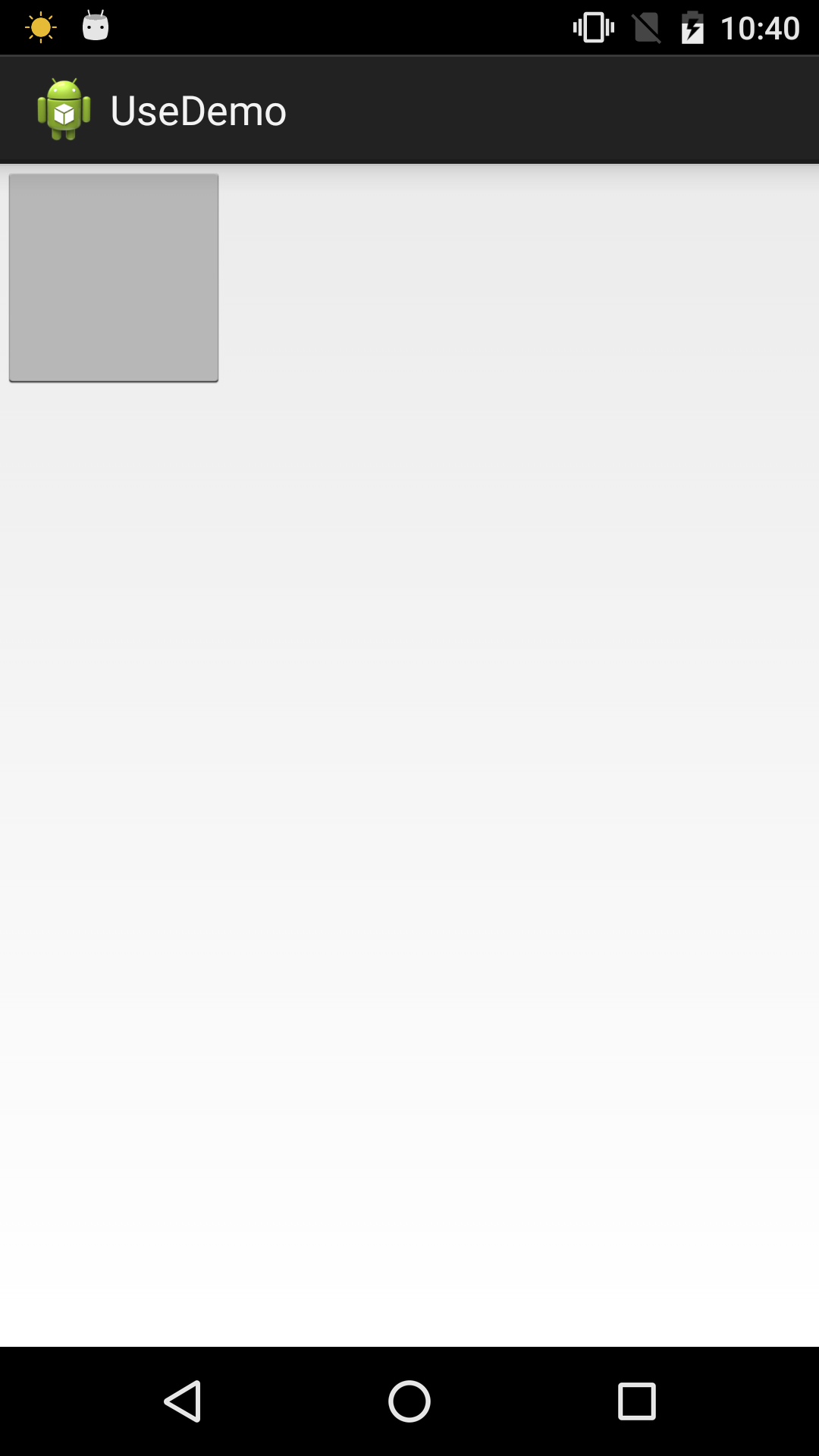前言
LayoutInflater,相信我们都不会陌生,在ListView里的getView方法里,我们都会使用,今天我们就来详细的分析下LayoutInflater的inflate方法,方便以后的工作中选择最适合的方法。
基本使用
LayoutInflater有以下三个方式,它们有什么不同呢,在我初学的时候,还真不清楚。
inflate(resource, null);
inflate(resource, parent, false);
inflate(resource, parent, true);那么这三种方式有什么不同呢?我们用实践来说明
activity_main.xml
<ListView xmlns:android="http://schemas.android.com/apk/res/android"
xmlns:tools="http://schemas.android.com/tools"
android:id="@+id/main_lv"
android:layout_width="match_parent"
android:layout_height="wrap_content" >
</ListView>item.xml
<Button xmlns:android="http://schemas.android.com/apk/res/android"
xmlns:tools="http://schemas.android.com/tools"
android:id="@+id/item_btn"
android:layout_width="100dp"
android:layout_height="100dp" >
</Button> MainAdapter.java
public class MainAdapter extends BaseAdapter
{
private LayoutInflater mInflater;
private List<String> mDatas;
public MainAdapter(Context context, List<String> datas)
{
mInflater = LayoutInflater.from(context);
mDatas = datas;
}
@Override
public int getCount()
{
return mDatas.size();
}
@Override
public Object getItem(int position)
{
return mDatas.get(position);
}
@Override
public long getItemId(int position)
{
return position;
}
@Override
public View getView(int position, View convertView, ViewGroup parent)
{
ViewHolder holder = null;
if (convertView == null)
{
holder = new ViewHolder();
convertView = mInflater.inflate(R.layout.item, null);
// convertView = mInflater.inflate(R.layout.item, parent ,false);
// convertView = mInflater.inflate(R.layout.item, parent ,true);
holder.mBtn = (Button) convertView.findViewById(R.id.item_btn);
convertView.setTag(holder);
} else
{
holder = (ViewHolder) convertView.getTag();
}
holder.mBtn.setText(mDatas.get(position));
return convertView;
}
private final class ViewHolder
{
Button mBtn;
}
}
MainActivity.java
public class MainActivity extends Activity {
private ListView mListView;
private MainAdapter mAdapter;
private List<String> mDatas = Arrays.asList("I", "Love", "Android");
@Override
protected void onCreate(Bundle savedInstanceState) {
super.onCreate(savedInstanceState);
setContentView(R.layout.activity_main);
mListView = (ListView) findViewById(R.id.main_lv);
mAdapter = new MainAdapter(this, mDatas);
mListView.setAdapter(mAdapter);
}
}我们关注的就是getView里的三个方法:
convertView = mInflater.inflate(R.layout.item, null);
// convertView = mInflater.inflate(R.layout.item, parent ,false);
// convertView = mInflater.inflate(R.layout.item, parent ,true); 分别运行,看看效果:
第一个:
第二个:
第三个:
Logcat:
Caused by: java.lang.UnsupportedOperationException: addView(View, LayoutParams) is not supported in AdapterView我们发现,第一个inflater(R.layout.item, null )不能正确的处理宽和高的值,而inflate(R.layout.item, parent ,false); 可以正确处理宽和高的值。至于第三个,则会报错。。。。下面我们就来从源码的角度来分析,第三个为什么会报错?
源码分析
我们看这三种形式都会进入的inflate方法:
public View inflate(XmlPullParser parser, ViewGroup root, boolean attachToRoot) {
synchronized (mConstructorArgs) {
Trace.traceBegin(Trace.TRACE_TAG_VIEW, "inflate");
final AttributeSet attrs = Xml.asAttributeSet(parser);
Context lastContext = (Context)mConstructorArgs[0];
mConstructorArgs[0] = mContext;
View result = root;
try {
// Look for the root node.
int type;
while ((type = parser.next()) != XmlPullParser.START_TAG &&
type != XmlPullParser.END_DOCUMENT) {
// Empty
}
if (type != XmlPullParser.START_TAG) {
throw new InflateException(parser.getPositionDescription()
+ ": No start tag found!");
}
final String name = parser.getName();
if (DEBUG) {
System.out.println("**************************");
System.out.println("Creating root view: "
+ name);
System.out.println("**************************");
}
if (TAG_MERGE.equals(name)) {
if (root == null || !attachToRoot) {
throw new InflateException("<merge /> can be used only with a valid "
+ "ViewGroup root and attachToRoot=true");
}
rInflate(parser, root, attrs, false);
} else {
// Temp is the root view that was found in the xml
View temp;
if (TAG_1995.equals(name)) {
temp = new BlinkLayout(mContext, attrs);
} else {
temp = createViewFromTag(root, name, attrs);
}
ViewGroup.LayoutParams params = null;
if (root != null) {
if (DEBUG) {
System.out.println("Creating params from root: " +
root);
}
// Create layout params that match root, if supplied
params = root.generateLayoutParams(attrs);
if (!attachToRoot) {
// Set the layout params for temp if we are not
// attaching. (If we are, we use addView, below)
temp.setLayoutParams(params);
}
}
if (DEBUG) {
System.out.println("-----> start inflating children");
}
// Inflate all children under temp
rInflate(parser, temp, attrs, true);
if (DEBUG) {
System.out.println("-----> done inflating children");
}
// We are supposed to attach all the views we found (int temp)
// to root. Do that now.
if (root != null && attachToRoot) {
root.addView(temp, params);
}
// Decide whether to return the root that was passed in or the
// top view found in xml.
if (root == null || !attachToRoot) {
result = temp;
}
}
} catch (XmlPullParserException e) {
InflateException ex = new InflateException(e.getMessage());
ex.initCause(e);
throw ex;
} catch (IOException e) {
InflateException ex = new InflateException(
parser.getPositionDescription()
+ ": " + e.getMessage());
ex.initCause(e);
throw ex;
} finally {
// Don't retain static reference on context.
mConstructorArgs[0] = lastContext;
mConstructorArgs[1] = null;
}
Trace.traceEnd(Trace.TRACE_TAG_VIEW);
return result;
}
}这里把我们关注的代码提出来:
View result = root;inflate(resId , null);
if (root == null || !attachToRoot) {
result = temp;
}inflate(resId , root, false);
if (root != null) {
params = root.generateLayoutParams(attrs);
if (!attachToRoot) {
// Set the layout params for temp if we are not
// attaching. (If we are, we use addView, below)
temp.setLayoutParams(params);
}
}inflate(resId , root, true);
if (root != null && attachToRoot) {
root.addView(temp, params);
}同过上述代码,我们发现:
Inflate(resId , null ) 只创建temp ,返回temp
Inflate(resId , root, false )创建temp,然后执行 temp.setLayoutParams(params);返回temp
Inflate(resId , root, true ) 创建temp,然后执行root.addView(temp, params);最后返回root
这样一来,我们就可以解释一开始出现不同状况的原因了:
Inflate(resId , null )不能正确处理宽和高是因为:layout_width,layout_height是相对了父级设置的,必须与父级的LayoutParams一致。而此temp的getLayoutParams为null
Inflate(resId , parent,false ) 可以正确处理,因为temp.setLayoutParams(params);这个params正是root.generateLayoutParams(attrs);得到的。
Inflate(resId , parent,true )不仅能够正确的处理,而且已经把resId这个view加入到了parent,并且返回的是parent,和以上两者返回值有绝对的区别,还记得文章前面的例子上,MyAdapter里面的getView报的错误:
Caused by: java.lang.UnsupportedOperationException: addView(View, LayoutParams) is not supported in AdapterView原因是调用了addView方法,而ListView是AdapterView的子类,在AdapterView里面有这么一段代码:
@Override
public void addView(View child) {
throw new UnsupportedOperationException("addView(View) is not supported in AdapterView");
} 现在我们清楚为什么会报错了。。。。
思考
既然第三种方式会默认调用addView方法,那么我们在Activity里写如下代码会是怎样?:
MainActivity.java
View view = LayoutInflater.from(this).inflate(R.layout.activity_main,
(ViewGroup)findViewById(android.R.id.content), true); activity_main.xml
<Button xmlns:android="http://schemas.android.com/apk/res/android"
xmlns:tools="http://schemas.android.com/tools"
android:id="@+id/item_btn"
android:layout_width="100dp"
android:layout_height="100dp" >
</Button>我们运行一下看看效果:
是的,虽然我们没有执行setContentView,但是依然可以看到绘制的控件,是因为
View view= mInflater.inflate(R.layout.activity_main,(ViewGroup)findViewById(android.R.id.content), true);
这个方法内部已经执行了root.addView(temp , params);
这样,以后我们在使用LayoutInflater时就可以选择最适合的方式了。。


























 700
700

 被折叠的 条评论
为什么被折叠?
被折叠的 条评论
为什么被折叠?








